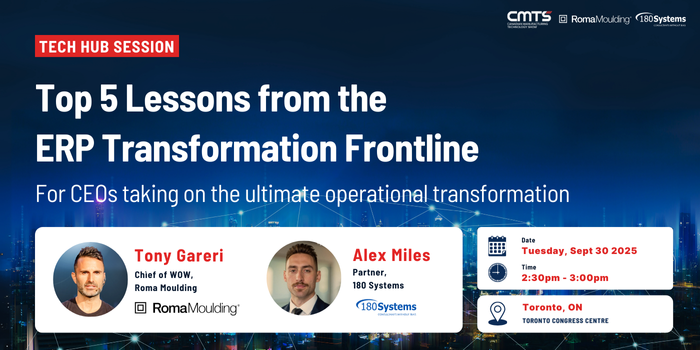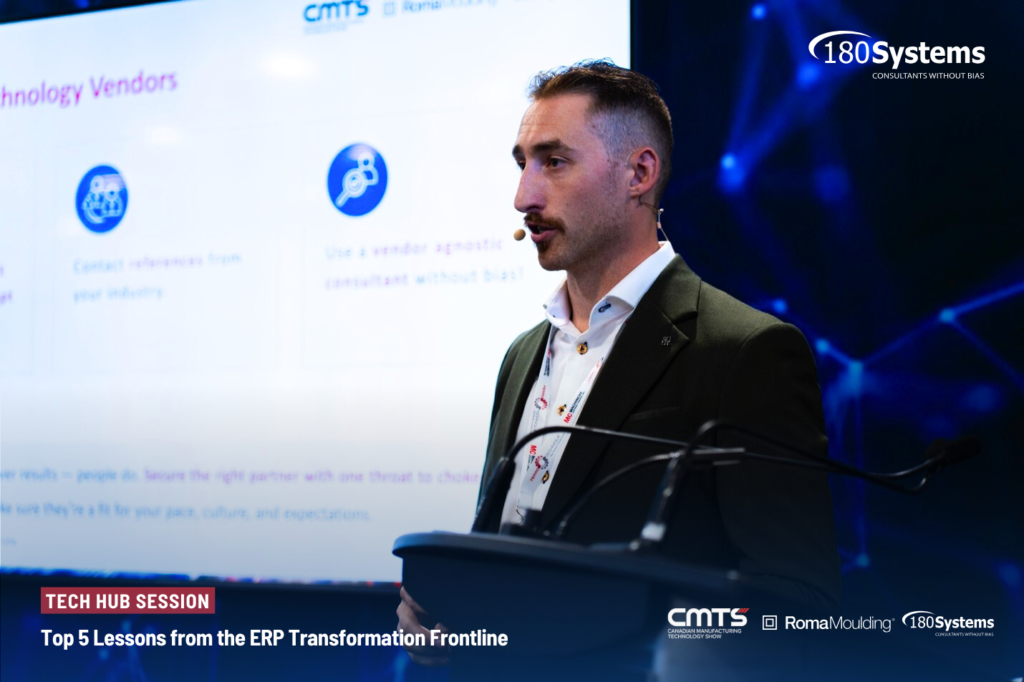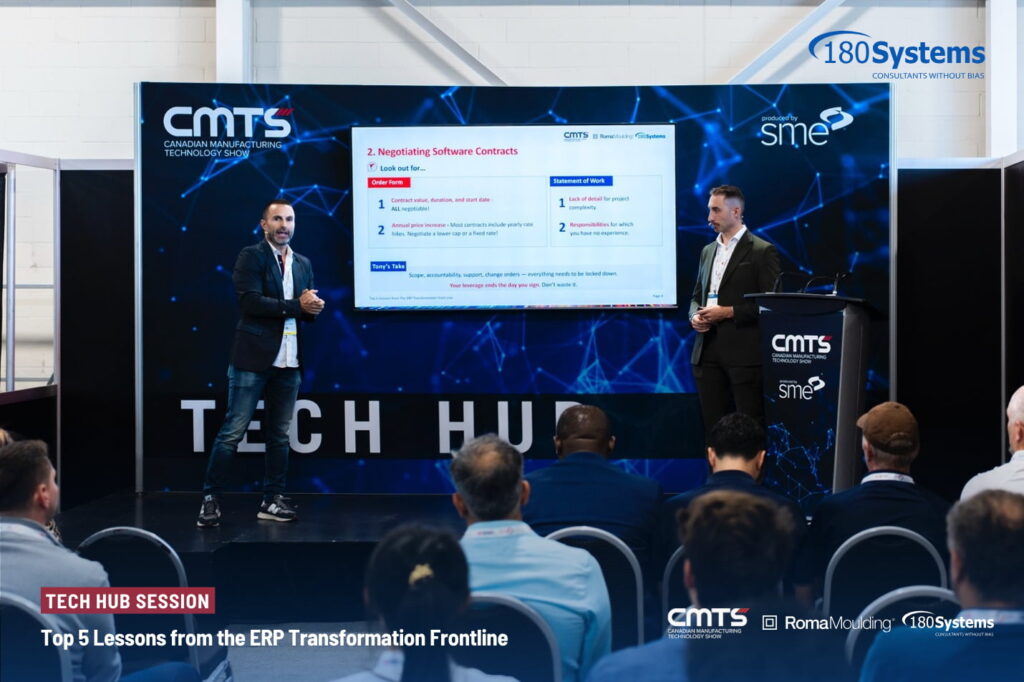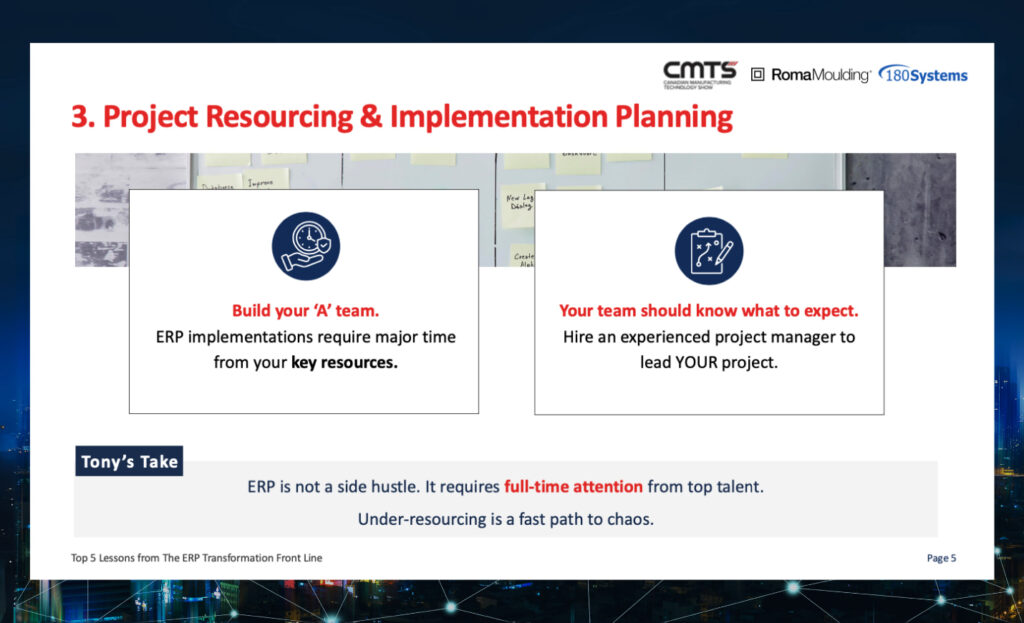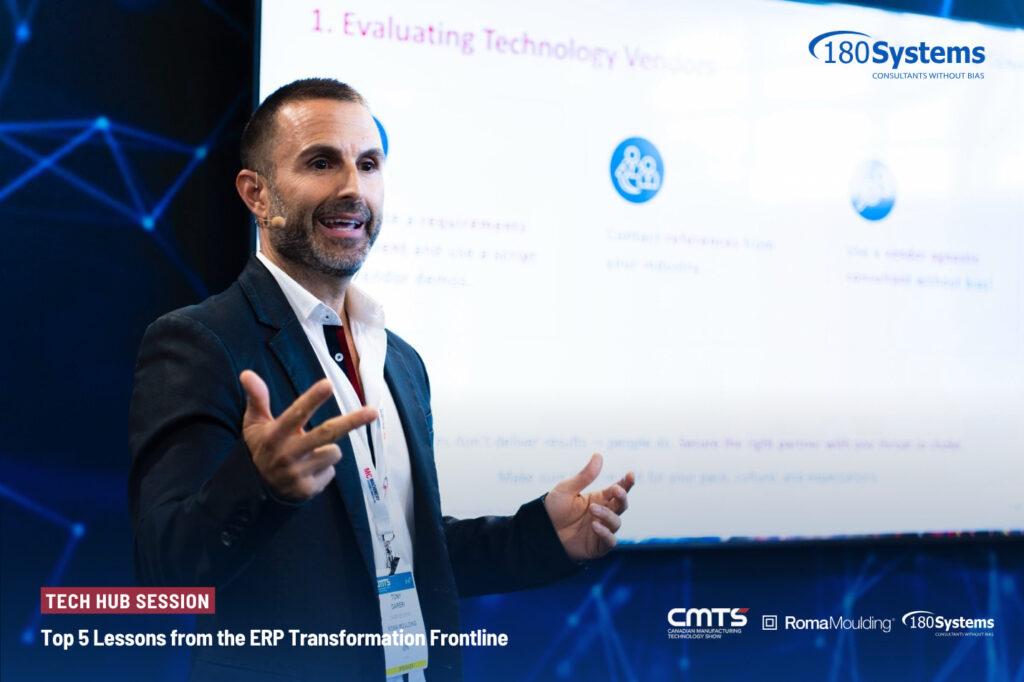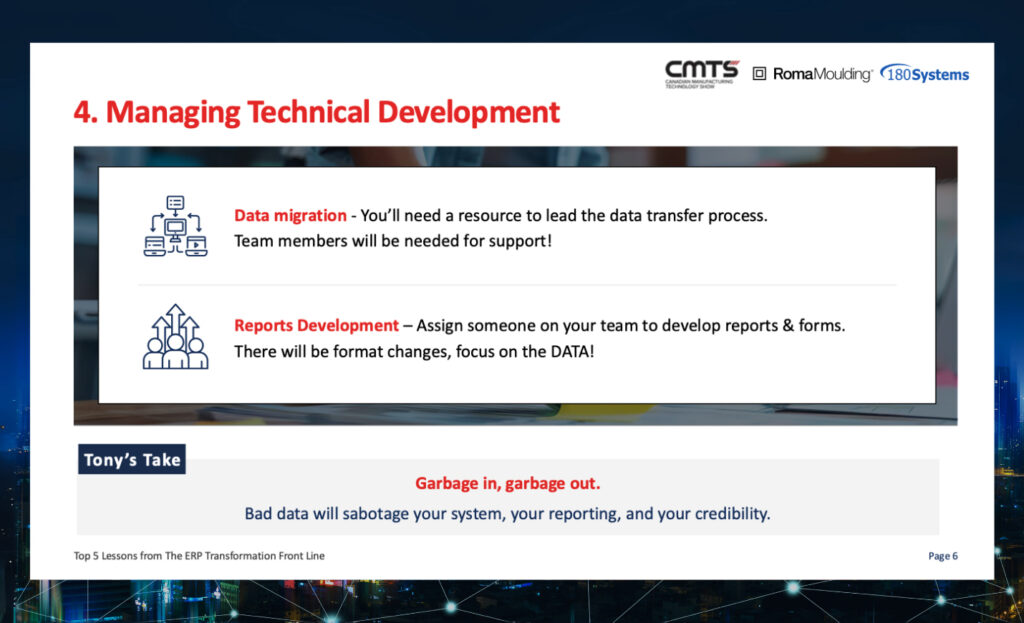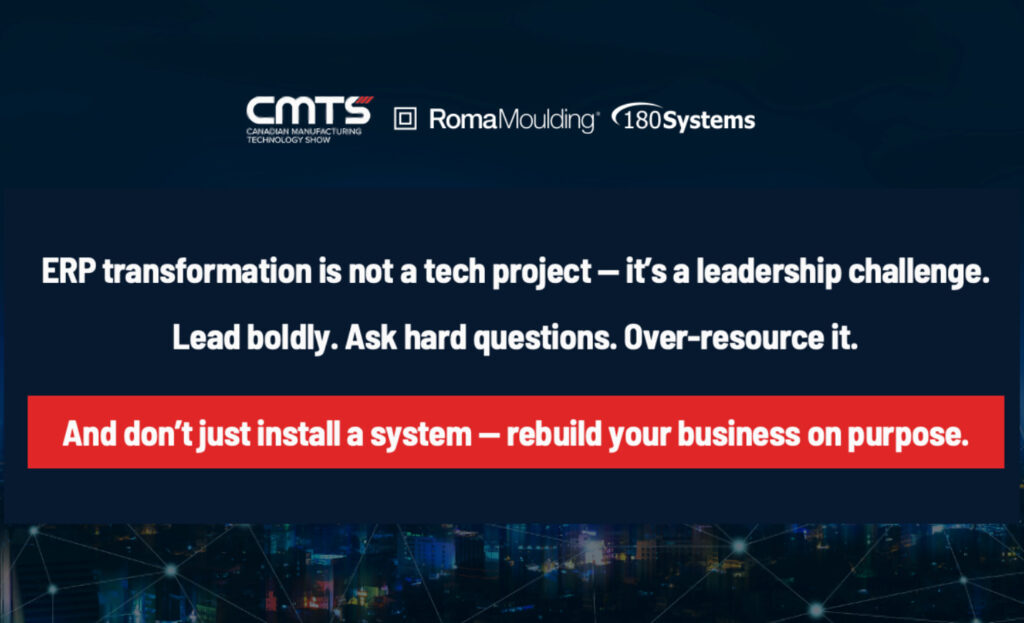By 180 Systems and Roma Moulding
At CMTS 2025, Alex Miles (Partner, 180 Systems) and Tony Gareri (CEO, Roma Moulding) shared a candid look at what it truly takes to lead an ERP transformation – from vendor selection to post-implementation leadership. Their joint presentation, “Top 5 Lessons from the ERP Transformation Front Line,” summarized hard-earned insights drawn directly from Roma’s ongoing ERP and CPQ journey.
ERP transformations are not just technology initiatives; they are leadership and organizational change challenges. The discussion offered practical, experience-based takeaways for any company preparing to embark on or recalibrate an ERP project.
1.Evaluating Technology Vendors
Selecting the right technology vendor is one of the most critical factors determining the success of an ERP project.
Alex emphasized that this process must be structured and led by the organization, rather than driven by the vendor. In practice, this means:
- Generating a detailed requirements document that clearly defines business processes, functional needs, and evaluation criteria.
- Preparing a scripted demo so that vendors present their solutions according to real business scenarios – not generic feature tours. This approach allows for objective comparison across different systems.
Beyond technical capabilities, vendor evaluation should also consider the people and the cultural fit. Even the best software will fail if the implementation team doesn’t align with the organization’s working pace, management style, or expectations.
Alex also recommended that organizations contact peer references within their industry to understand the vendor’s performance in real-world implementations — how they communicate, resolve issues, and support post-go-live operations. Doing so helps avoid costly mistakes caused by relying only on sales presentations.
Tony’s take:
“Features don’t deliver results – people do. Secure the right partner with one throat to choke. Make sure they’re fit for your pace, culture, and expectations.”
In short, Roma Moulding’s first lesson is clear: vendor selection isn’t just about choosing software – it’s about choosing the people who will help drive your transformation.
2. Negotiating Software Contracts
The contract stage is where leverage peaks – and disappears once the agreement is signed. Alex emphasized that this phase should be approached with the same discipline as the selection process. Every element that defines success – scope, accountability, support, change management, and ownership – must be explicitly documented.
Many organizations underestimate how much can be negotiated. Key contract components such as project duration, start date, and annual price increases are rarely fixed. Vendors often include annual rate escalations by default, but these can be capped or removed if addressed early. Similarly, vague Statements of Work (SOW) often conceal hidden risks such as unclear deliverables, missing roles, or responsibilities beyond the client’s experience — all of which should be clarified before signing.
Alex advised reviewing both the Order Form and SOW line by line to ensure transparency and accountability. This due diligence prevents disputes later when issues of scope or responsibility arise.
Tony’s perspective:
“Scope, accountability, support, change orders – everything needs to be locked down. Your leverage ends the day you sign. Don’t waste it.”
In essence, Roma Moulding’s second lesson underscores that negotiation is not just about price – it’s about protecting project integrity and ensuring shared accountability from day one.
3. Project Resourcing & Implementation Planning
ERP projects are not side initiatives – they are enterprise transformations that demand full-time attention from top talent. Alex emphasized that one of the most common causes of ERP failure is under-resourcing, both in time and capability.
Building an “A team” is critical. The project should include the organization’s best people, not just those who are available. Each team member must understand the project’s importance, the expected time commitment, and how their role connects to the broader transformation.
Equally important is appointing an experienced project manager – someone who can coordinate between internal stakeholders, vendors, and consultants. This role is essential to maintaining momentum, ensuring accountability, and managing communication across departments.
Proper implementation planning should also consider phasing and capacity. Teams need realistic timelines that reflect ongoing business operations, not ideal scenarios. Overly aggressive schedules or inadequate staffing often lead to burnout and poor decision-making.
Tony’s take:
“ERP is not a side hustle. It requires full-time attention from top talent. Under-resourcing is the fastest path to chaos.”
The key takeaway from Roma Moulding’s third lesson is straightforward: ERP success depends less on software and more on people allocation. The right structure, leadership, and commitment turn a complex implementation into an organized transformation.
4. Managing Technical Development
ERP technical development extends far beyond configuration — it requires disciplined data management, clear ownership, and consistent communication between business and technical teams. Alex highlighted that data migration is one of the most underestimated yet crucial phases of implementation. Organizations often assume this task will be handled entirely by the vendor, but in reality, internal ownership is essential.
Every company needs a dedicated resource to lead the data migration process, supported by cross-functional team members who understand the source systems and business logic behind the data. Data cleansing, mapping, and validation must be planned early, not left to the end of the project.
Reporting and form development are equally important. Too often, reporting requirements are treated as an afterthought, resulting in frustration post–go-live. Teams should assign an internal resource responsible for ensuring reports reflect the organization’s actual data priorities. The goal is not just to replicate old reports in a new system, but to improve data accuracy and insight.
Alex reiterated that data quality underpins every success metric. A modern ERP system cannot compensate for poor data – and once corrupted, inaccurate data can quickly erode trust in the new system.
Tony’s perspective:
“Garbage in, garbage out. Bad data will sabotage your system, your reporting, and your credibility.”
The fourth lesson from Roma Moulding’s ERP journey is clear: technical execution is only as strong as the discipline behind it. Proper data governance, internal accountability, and early attention to reporting requirements prevent technical debt and ensure the system delivers meaningful business value.
5. Managing Communication & Scope
Effective communication and scope control are what keep ERP projects from drifting off course. Alex emphasized that technology alone doesn’t fail – communication does. Successful ERP implementations depend on clear, consistent messaging from leadership and a disciplined approach to managing change.
Every project should begin with a formal communication plan that starts at the executive level. Leaders must communicate the “why” behind the transformation, the expected benefits, and the roadmap ahead. Silence, delays, or inconsistent messaging quickly erode trust and engagement across teams. When people don’t understand what’s happening, they fill in the blanks – often with resistance or fear.
Scope control is another pillar of execution discipline. Without strict governance, small change requests can accumulate and derail both budget and schedule. A change request (CR) process ensures that every proposed adjustment is documented, evaluated for impact, and approved only if it adds real business value.
Alex noted that effective ERP leadership means balancing flexibility with focus: adapt when it’s necessary, but protect the integrity of the project plan.
Tony’s perspective:
“ERP transformations aren’t tech projects – they’re leadership challenges. Lead boldly. Ask hard questions. Over-resource it. And don’t just install a system – rebuild your business on purpose.”
The final lesson from Roma Moulding’s journey underscores a truth that applies to every ERP initiative: the hardest part of transformation isn’t the software — it’s alignment. Clear communication, firm scope management, and visible leadership turn ERP from a technical rollout into a strategic rebuild of how the business operates.
Closing Reflection
The Roma Moulding experience offers a grounded perspective on what truly drives ERP success – leadership discipline, clarity of purpose, and operational readiness. While technology is a key enabler, it’s the human and organizational factors that determine whether a transformation delivers lasting value.
Alex summarized that ERP projects don’t end at go-live; they evolve. The real transformation happens afterward — when teams adapt processes, refine data, and integrate continuous improvement into daily operations. Companies that treat ERP as a one-time IT investment often fall short. Those that see it as a long-term business capability, however, build stronger, more resilient organizations.
ERP transformation is not about installing a system; it’s about rebuilding the business intentionally – with better data, clearer processes, and stronger alignment between strategy and execution.
Roma Moulding’s journey, as shared by Alex Miles and Tony Gareri, reinforces a simple truth:
The success of ERP is never accidental – it’s the product of preparation, communication, and courageous leadership.
—
About the Speakers
Alex Miles is the Partner at 180 Systems, an independent ERP consulting firm specializing in ERP selection, implementation governance, and business process transformation.
Tony Gareri is the CEO and “Chief of WOW” at Roma Moulding, a North American leader in moulding and framing products, recognized for its strong culture and people-first approach to business.
